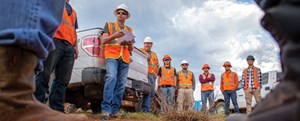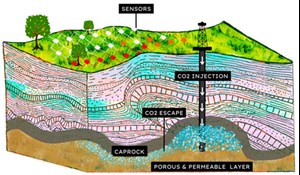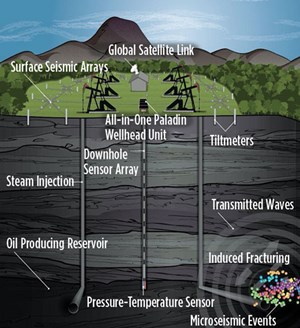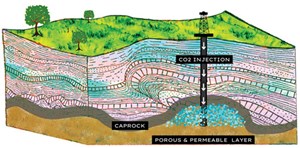Boots on the ground, eyes on the earth: How subsurface diagnostics is redefining sustainability
Sustainability is a bandwagon that every company is jumping on, but they’re doing it without knowing what the word actually means. I’m going to share my own definition of sustainability and how we apply that at ESG Solutions. Today, many companies—not just in the energy sector, but in every industry—talk about how they’re committed to sustainability. We’re all using the same word, so it sounds like we’re all on the same page. That’s good news, right? We’re all working together toward the same environmental goals. If you look closer, though, you can see that’s not always the case.
To us, sustainability means being operating stewards taking care of people and resources, above and below the earth’s surface. We have been doing that since our first day of business. To be fair, that’s what sustainability means to lots of other companies. But I also know that safety and regulation are driving sustainability.
Safety and regulation drive sustainability. ESG Solutions provides subsurface diagnostic tools to the natural resource market. Our purpose is to reduce cost and risk for mining, energy and geotechnical operations while improving safety and productivity. Safety and regulation are a big part of that. In fact, our company started because of safety and regulation. After multiple mining accidents in northern Ontario throughout the 1980s, a group of scientists at Queen’s University began exploring ways to identify and locate microseismic activity that could be a precursor to hazardous conditions.

Their goal was to learn what was happening underground and prevent the accidents and fatalities that were unfortunately so common in the mining industry. The group disbanded after a few years, but their research inspired a new company to form in 1993: Engineering Seismology Group Canada Inc., or ESG. One of our first-ever permanent seismic monitoring systems was installed at New York’s Retsof Salt Mine in 1994 after a mine collapse.
As a new company in the early 1990s, our service focus was a lot narrower than it is now. We were working mostly with underground mining operations at that time. These clients needed to know what was going on subsurface, so they could use the right amount of charges to break up the right amount of rock—not blasting far more than they needed to. It was also important to know when potentially dangerous seismic activity had subsided after blasting, meaning workers could safely go underground again. So, a lot of the mine systems we provided were not just for the mine’s efficiency, but also for the workers’ safety.
Benefit for global operations. This focus on safety led us to expand into oil and gas operations. We were among the first to use microseismics as a tool for shale gas extraction, which led us to develop hydraulic fracture imaging and interpretation. Since then, we have monitored injection applications throughout the world, including carbon capture and sequestration, to make sure it’s affecting the surrounding environment as little as possible and that the operation is going as planned. All of that is to say, we have seen operations worldwide benefit from getting the full picture underground. It’s not just for one industry, and it’s not just a particular kind of subsurface activity. It’s any operation that goes below the surface and has the potential to affect people and planet.
When the idea of sustainability started to take hold on an industry level, it didn’t take long for us to notice a pattern in our work. Weren’t we doing our best to make as little impact subsurface as possible? And wasn’t the goal of sustainability to produce natural resources in a responsible manner, and to take care of the earth, the workers, and the stakeholders? Through our focus on operational efficiency and worker safety, we found that we were naturally contributing to the earth’s well-being at the same time. That was a lightbulb moment for us. It became a guidepost by which we could ensure the company was moving in the right direction.
We do it right and help our customers do the same. Looking at everything from carbon sequestration to mining, we do it right and help our customers do the same. The by-product of investing in risk mitigation technologies is that it’s better for everyone—environment, people, economics. The energy industry prides itself on its safety-first culture. There’s a good reason for that. If a worker gets hurt on the job, of course the company cares about that worker, but the incident also affects the company’s bottom line. They lose productivity for that day. There will probably be an investigation, and the incident could potentially devalue the company.
At the end of the day, not focusing on safety will cost this company big time. Most companies believe that they wouldn’t be there without their employees, and that’s where ESG comes in. We are partners with our customers and work alongside them to create a safe environment for their employees and the structures they operate in.
Let’s say we’re providing reservoir monitoring for an energy company. We’re making sure our client is safely injecting into the reservoir, not breaking through the caprock and risking damage to the environment and ecosystem, Fig. 1. If our containment monitoring systems show they’re starting to break caprock or escape laterally, we can alert the client. They adjust operations, they can prevent a breach or an escape, and they don’t have to invest in long-term environmental remediation to fix a mistake, Fig. 2.
Real time monitoring enables visualization of how the earth responds to your actions. I will try another example. If you’re fracing and have a frac hit, you just wasted all the time, energy and resources it took to get the hydrocarbons to surface. Your production will drop, and you will also waste an enormous amount of materials on an inefficient stimulation program.
When you monitor in real time, you see how the earth responds to your actions. You can identify a plug slip and make adjustments to maintain pressure. You can adjust your frac’s distance from the well. You can frac fewer stages and get more out of the ones you have. You can use less product and less energy to get the same results—or better.

It’s astonishing to see some companies still haven’t turned on the lights in their subsurface manufacturing floors. They can’t see what’s happening underground, can’t be 100% sure what is going to happen.
You want a 360-degree view of what’s happening subsurface. Another example that ties in with sustainability is geothermal. With these types of operations, there are plenty of projects where the substructure presents challenges to efficient energy production. Producers spend an incredible amount of time and money designing their injection and production wells to create pathways for hot water production. But sometimes the execution doesn’t go as planned, leaving the engineers scratching their heads when they produce water that’s cooler than expected.
Historically, the engineers would turn to older, more obsolete technologies like injecting tracers to try and imagine fluid movement. Well, what if those tracers didn’t come out of the nearest well, but a well much farther away? Operators need a view into why. It’s just this type of situation where you want a 360-degree view of what’s happening subsurface. This is not a rare edge case. It happens more often than you might think; the plumbing in geothermal is wildly unconstrained and it’s hard to map appropriately. But when we deploy our toolbox of subsurface diagnostics with the client to identify and explore the connections between wells, they can make that system better.
For some clients, our work is more about reservoir containment. Some EOR operators find huge value in placing microseismic systems on each one of their pads. Instead of running expensive tests before each injection cycle to make sure pressure integrity is what it should be, they can monitor pressure and containment on just a small selection of wells for a fraction of the cost.
During one reservoir monitoring project, we saw microseismic activity outside of the reservoir, in a location where no one expected to see it. At first we thought it might be a fault. It was actually a well that wasn’t abandoned properly, so all the steam from this client’s operations was going up that well. If we hadn’t been monitoring, they might not have been able to pinpoint the problem and take the appropriate action.

When you have boots on the ground, you have to keep your eyes on the earth. From the very beginning, we have been showing our clients the impacts of their decisions before they become disasters. Strong seismic activity can cause catastrophic damage to mines. Carbon sequestration can escape from the formation. Saltwater disposal operations can induce seismicity.
When you have boots on the ground, you must keep your eyes on what’s happening subsurface. Being able to observe what’s going on subsurface allows for real-time decision-making and mitigation. That’s critical in situations where every moment counts.
Let’s look at a hydraulic fracturing example. The client’s operations are inducing large seismic events, which can be felt on the surface. We set up a regional seismic array to give the client the ability to detect induced events in real time. They can make operational changes as soon as they start seeing precursor activity, indicating there’s about to be a large seismic event. The client can now react instantaneously to protect both their operations and any nearby communities.
This is huge for maintaining not only their license to operate, but also the impact they’re making on the earth.
Invest in diagnostics, and the results will be better across the board. Whatever the operation, our approach comes down to one thing for the client: only doing what they need to have done. They won’t be wasting time, money and materials drilling more holes, pumping more fluid, using more explosives, or digging deeper than they absolutely have to. Invest in diagnostics, and the results will be better across the board.
Improvement is going to come from technology. Right now, we are integrating a toolbox of innovative subsurface diagnostic techniques that are tailor-fit for a customer’s specific operations. We combine microseismics with fiber-optic strain monitoring, electromagnetic fluid tracking, and large-event detection protocols, Fig. 3. Instead of just offering clients one or two tools, we can mix and match for a holistic view of what’s going on underground.
Our internal research and development is always focused on getting this big picture subsurface. We have started implementing artificial intelligence and machine learning to inform our efforts. As humans, we’re limited to what we can currently understand. The data are showing us more trends to follow for the best possible outcomes.
It’s not just us, either. Others are developing new technologies that create solutions to problems we used to think were unsolvable. Any company can do that, not just businesses in the energy sector. All it takes is never accepting that it can’t be done, or that it can’t be done safely. The dividends are there, as long as you don’t cut corners. When your company is thinking about how to be more eco-friendly, start by knowing what you’re dealing with, look for ways to reduce waste and impact, and always be ready to adjust as the situation changes. And whatever you’re doing subsurface, just make sure you’re doing it sustainably—even if sustainability means sending people home safely at the end of the day.

- Advancing offshore decarbonization through electrification of FPSOs (March 2024)
- Digital transformation: Accelerating productivity, sustainability in oil and gas (November 2023)
- Technological advances increase efficiencies and flexibility (November 2023)
- Volatile organic carbon emissions in oil and gas industry: Impact and mitigation (November 2023)
- Technological innovation delivers transformative product suite to upstream sector (November 2023)
- Executive viewpoint (August 2023)
- Applying ultra-deep LWD resistivity technology successfully in a SAGD operation (May 2019)
- Adoption of wireless intelligent completions advances (May 2019)
- Majors double down as takeaway crunch eases (April 2019)
- What’s new in well logging and formation evaluation (April 2019)
- Qualification of a 20,000-psi subsea BOP: A collaborative approach (February 2019)
- ConocoPhillips’ Greg Leveille sees rapid trajectory of technical advancement continuing (February 2019)



